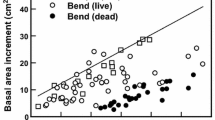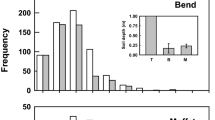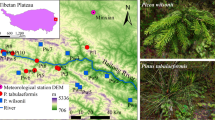Abstract
Frost damage and re-foliation are seldom quantified for forest species, but are of ecological and evolutionary importance. This study of Aesculus glabra (Ohio buckeye) in a deciduous forest remnant in Illinois, USA, quantified frost damage to leaves and flowers after sub-freezing temperatures in April 2007. It also documented re-foliation and later growth, reproduction, and survival in 2007–2009 for the 355 study individuals of four life stages growing 0–200 m from the forest edge. Life stages differed in % leaf damage because of differences in phenology during the frost. Large saplings with fully expanded, immature leaves had higher % damage and lower % canopy fullness after re-foliation than smaller saplings with partially or fully mature leaves and canopy trees undergoing shoot expansion with folded leaflets. Percent damage increased for saplings closer to edges. Large saplings with heavier frost damage to leaves had partial re-foliation in deep shade, lower % canopy fullness, earlier senescence, a shorter growing season, and greater death of next year’s buds. By 2008, large saplings with greater damage in 2007 had more dead branches and lower % canopy fullness. By 2009, 11% of large saplings had died. In 2007, frost damaged no flowers, but final fruit crop size was negatively related to % leaf damage. Edge trees with total leaf damage aborted all fruits. The frost event differentially affected individuals in their length and time of growing season, energy budget, and, ultimately, reproduction, and survival. The population’s local-scale demography and spatial pattern also changed as large saplings died.


Similar content being viewed by others
References
Angel JR (2007) The April 2007 hard freeze in Illinois: features and impacts—Illinois State Water Survey Data/Case Study 2007–2005. Champaign, IL, p 22. ISWS DCS 2007–2005. http://www.isws.illinois.edu/pubdoc/DLS/ISWSDCS2007-05.pdf. Accessed 26 June 2007
Augspurger CK (2004) Developmental vs. environmental control of early leaf phenology in juvenile Ohio buckeye (Aesculus glabra). Can J Bot 82:31–35
Augspurger CK (2008) Early spring leaf out enhances growth and survival of saplings in a temperate deciduous forest. Oecologia 156:281–286
Augspurger CK (2009) Spring 2007 warmth and frost: phenology, damage, and refoliation in a temperate deciduous forest. Funct Ecol 23:1031–1039
Augspurger CK, Bartlett EA (2003) Differences in leaf phenology between juvenile and adult trees in a temperate deciduous forest. Tree Physiol 23:517–526
Augspurger CK, Cheeseman JM, Salk CF (2005) Light gains and physiological capacity of understorey woody plants during phenological avoidance of canopy shade. Funct Ecol 19:537–546
Clarke WS Jr (1946) Effect of low temperatures on the vegetation of the Barrens in central Pennsylvania. Ecology 27:188–189
Crawley M, Long CR (1995) Alternate bearing, predator satiation, and seedling recruitment in Quercus robur L. J Ecol 83:683–696
Geiger R (1965) The climate near the ground. Harvard University Press, Cambridge
Gu L, Hanson PJ, Post WM et al (2008) The 2007 Eastern US spring freeze: increased cold damage in a warming world? Bioscience 58:253–262
Gutschick VP, BassiriRad H (2003) Extreme events as shaping physiology, ecology, and evolution of plants: toward a unified definition and evaluation of their consequences. New Phytol 160:21–42
Hacke U, Sauter JJ (1996) Xylem dysfunction during winter and recovery of hydraulic conductivity in diffuse-porous and ring-porous trees. Oecologia 105:435–439
Inouye DW (2000) The ecological and evolutionary significance of frost in the context of climate change. Ecol Lett 3:457–463
Inouye DW (2008) Effects of climate change on phenology, frost damage, and floral abundance of montane wildflowers. Ecology 89:353–362
Joos LA (1960) Freeze probabilities in Illinois. Bull 650 University of Illinois Agricultural Experiment Station in Cooperation with the U.S. Weather Bureau
Korstian CF (1921) Effect of a late spring frost on forest vegetation of the Wasatch Mountains of Utah. Ecology 2:47–542
Kramer PJ, Kozlowski TT (1979) Physiology of woody plants. Academic Press, New York
Langvall O, Löfvenius MO (2002) Effect of shelterwood density on nocturnal near ground temperature, frost injury risk and budburst date of Norway spruce. For Ecol Manag 168:149–161
Lopez OR, Farris-Lopez K, Montgomery RA, Givnish TT (2008) Leaf phenology in relation to canopy closure in Southern Appalacian forests. Am J Bot 95:1395–1407
Luken JO (1990) Gradual and episodic changes in the structure of Rhus typhina clones. Bull Torrey Bot Club 117:221–225
Mooney HA (1977) Frost sensitivity and resprouting behavior of analogous shrubs of California and Chile. Madrono 24:74–78
Neilson RP, Wullstein LH (1983) Biogeography of two southwest American oaks in relation to atmospheric dynamics. J Biogeogr 10:275–297
Nixon CM, McCain WW (1969) Squirrel population decline following a late spring frost. J Wildl Manag 33:353–357
Robeson SM (2002) Increasing growing-season length in Illinois during the 20th century. Clim Change 52:219–238
Rose AH (1958) The effect of defoliation on foliate production and radial growth of quaking aspen. For Sci 4:335–342
Sakai A (1981) Freezing resistance of trees of the south temperate zone, especially subalpine species of Australasia. Ecology 62:563–570
Sakai A, Larcher W (1987) Frost survival of plants: responses and adaptation to freezing stress. Ecological studies, vol 62. Springer-Verlag, Berlin
Spurr SH (1957) Local climate in the Harvard forest. Ecology 38:37–46
Strain BR (1966) The effect of a late spring frost on the radial growth of variant quaking aspen biotypes. For Sci 12:334–337
Tryon EH, True RP (1964) Relative susceptibility of Appalachian hardwood species to spring frosts occurring after bud break. West Virginia University Agricultural Experiment Station Bulletin 503. Morgantown, West Virginia
Acknowledgments
The author thanks Steve Buck for site management, A. Miller-Rushing and C. F. Salk for constructive comments on an earlier draft, J. M. Cheeseman for assistance with figures, and the Illinois State Water Survey for climate data.
Author information
Authors and Affiliations
Corresponding author
Rights and permissions
About this article
Cite this article
Augspurger, C.K. Frost damage and its cascading negative effects on Aesculus glabra . Plant Ecol 212, 1193–1203 (2011). https://doi.org/10.1007/s11258-011-9897-z
Received:
Accepted:
Published:
Issue Date:
DOI: https://doi.org/10.1007/s11258-011-9897-z




